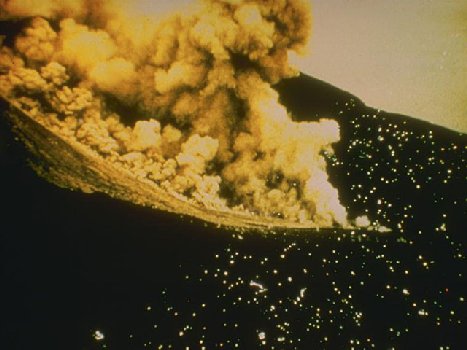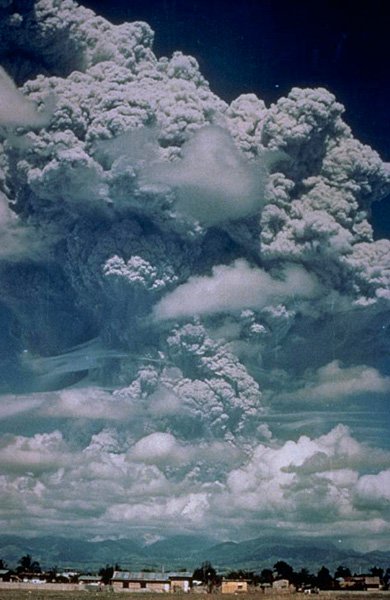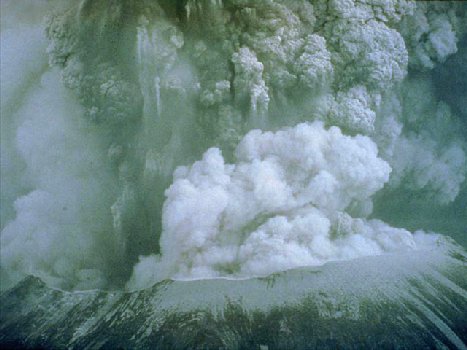| Volcanic Eruptions |
| Around 200,000 people have been killed by volcanic eruptions over the last 500 years. Like earthquakes, volcanoes are associated with tectonic plate boundaries, particularly subduction zones, but also with mid-plate mantle hotspots, such as the one underlying the Hawaiian Islands. Volcanoes are hazardous in a number of ways.
Mount Hood, Oregon, has the cone-shaped profile characteristic of volcanoes.
Eruption of a lava fountain from the Pu'u O'o vent on the eastern side of Kilauea, Hawaii.
The cinder cone Paricutin grew out of a Mexican cornfield from 1943-52, reaching a height of 410 metres (1107 feet). The eruption of lava at 1,100°C represents an obvious hazard to any living thing in its path. However, non-explosive lava eruptions, such as those from the Hawaii chain, are comparatively safe once they are underway. Explosive eruptions, on the other hand, are highly dangerous. Stiff magma with a high gas content is more likely to erupt explosively. Fragments of rock and ash (pyroclasts) can be ejected and quickly accumulate on the volcano's slopes. Such an eruption buried the town of Pompeii on the slopes of Vesuvius in 79AD. Ash from the eruption of Mount Pinatubo in 1992 quickly turned to mudflows (lahars) in heavy rain, accounting for most of the deaths and damage.
Lava at high temperatures can flow down-slope very quickly - up to 16 km per hour.
A crust has formed on this slow-moving Hawaiian lava flow.
Vehicles caught by a lava flow on Kilauea in October 1987. Pyroclastic flows are among the most dangerous forms of eruption: hot material can move very quickly downslope - up to 700km )437 miles) per hour and sometimes for tens of kilometres. A pyroclastic flow on the island of Martinique in 1902 killed 29,000 people instantly. Hot gases can support a high eruption column, carrying material tens of kilometres into the atmosphere and many thousands of kilometres laterally. Airliner engines have failed due to the ingestion of volcanic material over Alaska and southeast Asia.
Eruption of steam and ash triggers lightning above the volcano Galunggung on the island of Java, which killed 68 people in 1982.
A pyroclastic flow at Lamington, Papua New Guinea, in 1951. Flows moving at 100 km (62 miles) per hour killed 3,000.
Mount Pinatubo in the Philippines sent material 20 km (12.5 miles) into the stratosphere in 1990.
Ash deposits from Pinatubo buried many homes. The most devastating eruptions occur when the structure of the volcano itself is breached, leading to lateral blasts as magma is very rapidly exposed to atmospheric temperatures and pressures. During an eruption in 1980, the north flank of Mount St Helens bulged then slumped outwards, leading to a lateral blast which devastated 600 sq. km of the surrounding forest and killed 63. When Krakatoa blew up in 1883, 36,000 people died in the ensuing tsunamis.
A cloud of hot gas and pyroclasts rises from Mt St Helens during the 1980 eruption. |










